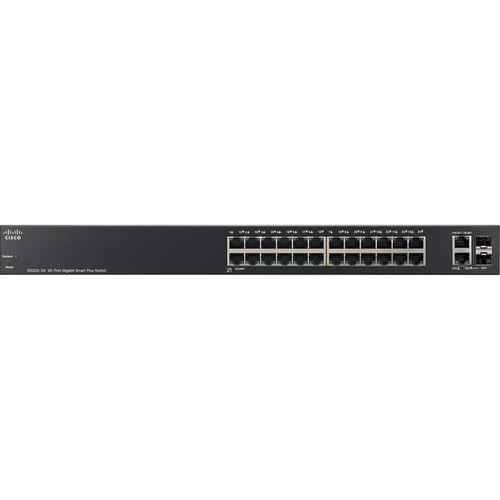Cisco SG220-26 Smart Switch with 26 x Gigabit Ethernet Ports
$195.99
In stock
Description
Add secure and energy-saving switching capacity to a small mid-size corporate network with the SG220-26 Smart Switch from Cisco. The SG220-26 Smart Switch comes equipped with 24 Gigabit RJ45 ports, two Gigabit combo RJ45/SFP uplink ports, a total switching capacity of 52 Gb/s and a total forwarding capacity of 38.69 Mpps. Boasting 128MB of processor RAM, the SG220-26 comes with security features such as 802.11x authentication, guest VLANs, access control lists, and denial of service protection, while support for Energy-Efficient Ethernet helps to conserve power during low-activity periods.
Additional information
| Weight | 8.8 lbs |
|---|---|
| Dimensions | 21 × 12.5 × 4.1 in |
| Ports | 24 x 10/100/1000 Mb/s Gigabit Ethernet (RJ45)<br />2 x 10/100/1000 Mb/s Gigabit Combo (Ethernet/SFP) (Uplink) |
| Flash Memory | 32 MB |
| Cooling System | Passive |
| Certifications | C-Tick, CE, CSA, FCC, UL, as per Manufacturer |
| Storage Humidity | 10 to 90% |
| Storage Temperature | -4 to 158°F / -20 to 70°C |
| Operating Humidity | 10 to 90% |
| Operating Temperature | 32 to 122°F / 0 to 50°C |
| AC Input Power | 100 to 240 VAC, 50 / 60 Hz |
| Power Draw | 18.9 W |
| Memory | 128 MB |
| Packet Buffer | 4.1 MB |
| Layer Services Supported | Layer 2 Support |
| Switching Bandwidth | 52 Gb/s |
| Forwarding Rate | 38.69 Mpps |
| Supported IEEE Standards | 802.1d, 802.1q/p, 802.1s, 802.1w, 802.1x, 802.3, 802.3ab, 802.3ad, 802.3af, 802.3at, 802.3az, 802.3u, 802.3x, 802.3z |
| RFC | RFC 768<br />RFC 791<br />RFC 792<br />RFC 793<br />RFC 813<br />RFC 826<br />RFC 854<br />RFC 855<br />RFC 856<br />RFC 858<br />RFC 879<br />RFC 896<br />RFC 894<br />RFC 919<br />RFC 920<br />RFC 922<br />RFC 950<br />RFC 1042<br />RFC 1071<br />RFC 1123<br />RFC 1141<br />RFC 1155<br />RFC 1157<br />RFC 1215<br />RFC 1493<br />RFC 1624<br />RFC 1700<br />RFC 1867<br />RFC 1981<br />RFC 2012<br />RFC 2013<br />RFC 2233<br />RFC 2460<br />RFC 2618<br />RFC 2665<br />RFC 2666<br />RFC 2674<br />RFC 2737<br />RFC 2819<br />RFC 2863<br />RFC 3416<br />RFC 3484<br />RFC 4007<br />RFC 4291<br />RFC 4443<br />RFC 4861<br />RFC 4862 |
| SNMP Support | 1, 2c, 3 |
| Security Features | DoS Attack Prevention<br>RADIUS Authentication<br>Storm Control |
| Jumbo Frames Support | 9216 Bytes |
| Transmission Method | Store-and-Forward |
| Queuing | Strict Priority, Weighted Round Robin (WRR) |
| Supported Protocols | Head-of-Line (HOL) Blocking<br>IGMP Snooping<br>IPv4<br>IPv6<br>Link Aggregation<br>MAC Filtering |
| Indicator Lights | Link/Activity, Speed, System |
Reviews (2)
2 reviews for Cisco SG220-26 Smart Switch with 26 x Gigabit Ethernet Ports
Only logged in customers who have purchased this product may leave a review.
Related products
Wired Networking
Wired Networking
Cisco SG250-50 250 Series 50-Port Managed Gigabit Ethernet Switch
Wired Networking
Wired Networking
Synology E25G21-F2 Dual 25G Ethernet SFP+ Port PCIe 3.0 Adapter
Wired Networking
Cisco RV345P 16-Port Gigabit PoE+ Compliant Router with Dual WAN
Wired Networking



Edwardo Wisozk (verified owner) –
I have it set up behind a Cisco RV345P router. There were no issues setting it up.
Anthony Braun (verified owner) –
I wanted to be able to have several VLANs (main, guest, VOIP, ISP, etc.) and be able to log in either over SSH or a serial line to be able to adminster the switch. A few others I have tried were OK, but this is superior to me in a few ways. Cisco has lead the industry in defining how to adminster these sorts of devices, practically writing the de-facto CLI standard. So this was easy to learn how to do most things. Anything which was not familiar is backed up by good documentation. When things in the CLI are not so easy, it does have Web pages for administration. A few other switches I have experience with are good, but for the home, they are noisey. Even one rated at -35 dB (farily quiet, sometimes described as being in a public library) was noticeable. Since this has no fan, it is silent. The only thing I might do differently if I were the design engineer would be to space adjacent port LEDs further apart. It’s difficult at a glance at them other than close up and straight on to tell which LED is for which port. If they were instead closer to the center of each port, the LEDs of adjacent ports would not be right together.